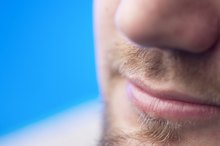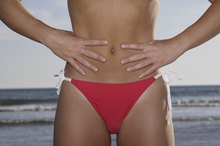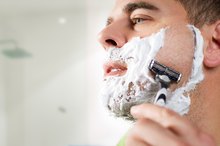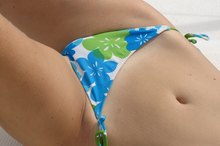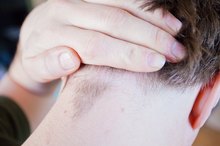How to Remove Perianal Hair
The perianal area is located around the anus and may include the perineum, the strip of skin between the anus and genitals. Hair growth in this area is natural but may be removed for cosmetic reasons. Shaving the perianal is not recommended due to the risk of cuts and infection. Waxing is the easiest and safest method of removing hair around the anus at home, and the results of waxing typically last three to six weeks, according to the Nemours Foundation 2.
Wash your perianal area thoroughly with warm water and a gentle soap. A large number of bacteria tend to reside in the area, which makes the chance of infection from broken or irritated skin high.
How to Prevent Ingrown Hairs in a Moustache
Learn More
Lie down on your back with a mirror positioned near your feet, or squat over a mirror to improve your ability to see the area. You will need to see the entire region to apply the wax properly.
Trim your perianal hair to about 1/4 inch with scissors if it is longer than 1/2 inch. This will make hair removal easier and may decrease your discomfort during waxing. According to the Nemours Foundation, waxing is most effective on hair that is at least 1/4 inch as shorter hairs may not adhere to the wax for removal 2.
How to Trim Pubic Hair for Women
Learn More
Use your left hand to pull the skin on one side of your anus taut, and then spread no-heat wax on the area using your right hand and the stick or applicator included with the product.
Press the cloth strip against the wax and rub your hand back and forth across the strip until it securely adheres to your hair and skin. If no cloth strips were included with your waxing kit, you can purchase them at most pharmacies and beauty supply stores.
Grab one end of the cloth strip and quickly pull it toward the opposite end of the strip. Keep the strip as close to your body as possible at all times. Pulling the strip away from your body, such as at a 90-degree angle, will increase pain and inflammation.
Repeat this process on the other side of your anus and on any remaining hair. Do not wax over the same area twice in the same day.
Remove any remaining wax by soaking a cotton ball in baby oil and wiping it across your skin. The wax should come away easily.
Apply a waxing gel or moisturizing ointment to your skin to help prevent dryness and ingrown hairs. Aloe vera gel is also useful for soothing the skin and preventing razor burn, explains the Palo Alto Medical Foundation 3.
Tips
Electrolysis and laser hair removal offer more permanent methods of removing perianal hair. However, these procedures may be expensive and painful.
Related Articles
References
- Planned Parenthood: The Hair Down There
- Nemours Foundation: Hair Removal
- Palo Alto Medical Foundation: Pubic Hair Removal: Shaving
- International Society for Sexual Medicine. What are the health risks of removing women's pubic hair?
- Carniciu AL, Chou J, Leskov I, Freitag SK. Clinical presentation and bacteriology of eyebrow infections: The Massachusetts Eye and Ear Infirmary experience (2008-2015). Ophthalmic Plast Reconstr Surg. 2017;33(5):372-375. doi:10.1097/IOP.0000000000000797
- U.S. Food and Drug Administration. Removing Hair Safely. Updated June 30, 2010.
- Desruelles F, Cunningham SA, Dubois D. Pubic hair removal: a risk factor for 'minor' STI such as molluscum contagiosum? Sex Transm Infect. 2013 May;89(3):216. doi:10.1136/sextrans-2012-050982
- Herbenick D, Hensel D, Smith NK, et al. Pubic hair removal and sexual behavior: findings from a prospective daily diary study of sexually active women in the United States. J Sex Med. 2013 Mar;10(3):678-85. doi:10.1111/jsm.12031
- Center for Young Women's Health. Removing Pubic Hair. Updated April 29, 2019.
- Truesdale MD, Osterberg EC, Gaither TW, et al. Prevalence of Pubic Hair Grooming-Related Injuries and Identification of High-Risk Individuals in the United States [published correction appears in JAMA Dermatol. 2017 Nov 1;153(11):1201]. JAMA Dermatol. 2017;153(11):1114–1121. doi:10.1001/jamadermatol.2017.2815
- Tanner J, Norrie P, Melen K. Preoperative hair removal to reduce surgical site infection. Cochrane Database Syst Rev. 2011 Nov 9;(11):CD004122. doi:10.1002/14651858.CD004122.pub4
- Castronovo C, Lebas E, Nikkels-Tassoudji N, Nikkels AF. Viral infections of the pubis. Int J STD AIDS. 2012 Jan;23(1):48-50. doi: 10.1258/ijsa.2011.010548.
Writer Bio
Sandra Ketcham has nearly two decades of experience writing and editing for major websites and magazines. Her work appears in numerous web and print publications, including "The Atlanta Journal-Constitution," "The Tampa Bay Times," Visit Florida, "USA Today," AOL's Gadling and "Kraze Magazine."
